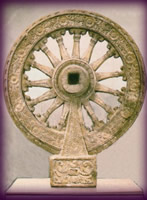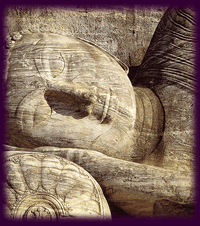
dharmachakra
(teaching wheel)

Buddha’s
footprint
Following this ‘great departure’, Gautama first studied philosophy under a Brahmanic master. He assimilated the doctrine quickly, but, considering it inadequate, left to study yoga with another master. Following his yogic apprenticeship—and having acquired five disciples of his own—he moved on yet again, and for the next six years indulged in rigorous mortification, at one point allegedly subsisting on one millet seed a day.
Eventually, understanding the uselessness of asceticism as a means of deliverance, he broke his fast. Now able to proclaim that he had mastered philosophy, ascetic and yogic practices—just as, earlier he had experienced all the pleasures of the princely life—it was his belief that he had been exposed to the full range of human experience.
At the time, ascetics enjoyed considerable prestige, and when he forsook his fast he was abandoned by his disciples. Restored by the gift of a bowl of rice, he travelled alone to a forest in Benares where, at the foot of a pipal tree, he sat down, determined not to rise until he had finally achieved his awakening (bodhi).
The actual nature of what Siddhartha Gautama subsequently experienced has come down to us in frankly mythical terms. Before he could even begin to meditate he was assaulted by Mara, a figure embodying both death and desire, who tried to destroy his resolve through firstly terror and then temptation. When that failed to work, Siddhartha settled into a deepening meditation, which enabled him to embrace, by virtue of his inner sight, the totality of worlds and their eternal becoming. In the second watch of the night, his life—and all previous incarnations—passed before his eyes. It was during the final watch that he understood the laws of mutual dependence keeping the wheel of existence going, at the same time as he worked out the conditions necessary to halt this endless cycle.
By the time the sun was rising he had in his possession the four ‘noble truths’. He had now become buddha, i.e. ‘awakened’.

nirvana
It is said that he remained for seven weeks in a heightened state of enlightenment, during which time Mara approached yet again to encourage him to enter immediately into nirvana and forsake proclaiming his newly discovered doctrine of salvation. The Buddha resisted this temptation, replying that he wouldn’t leave this existence until he had founded a well-established community of believers.
The primary focus of Buddhism is on the Buddha’s teaching, not on his person, and in the centuries immediately following his death, he was most often represented by a footprint (representing his impact) or the teaching wheel (dharma, ‘truth’ or ‘nature’; chakra, ‘wheel’). The heart of his teaching was the four noble truths, which he expounded in his first sermon, delivered to his five former disciples at Benares: 1) all is suffering 2) the origin of suffering is desire 3) delivery from desire abolishes suffering and 4) there is a way to achieve this. The Buddha’s cure for the ills of existence became known as the ‘middle’ way, as it avoided the two extremes of the pursuit of sensory pleasure and the search for spiritual bliss through excessive asceticism.
Siddhartha Gautauma successfully completing his mission in his 80th year. He then retired to a small hamlet, where, lying on a couch he peacefully entered nirvana (literally, ‘extinction, blowing out’; the complete cessation of suffering and the peace that results from this cessation). His final words were: “All things are impermanent—strive on with diligence.”